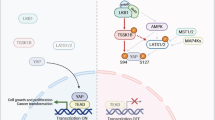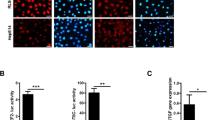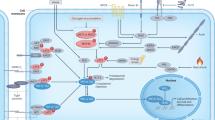Abstract
Background
To investigate whether the YAP/TAZ (Yes-associated protein/transcriptional coactivator with PDZ binding motif) pathway contributes to the pathogenesis of lymphatic malformations (LMs).
Methods
YAP, TAZ, CTGF (connective tissue growth factor), and Ki-67 were detected in LMs by immunohistochemistry. The colocalization of YAP and Ki-67 was analyzed by double immunofluorescence. Pearson’s correlation and cluster analyses were performed to analyze the relationships between these proteins. Human dermal lymphatic endothelial cells (HDLECs) were used for mechanistic investigation. Rat models of LMs were established to investigate the role of the YAP pathway in LM development.
Results
Compared with those in normal skin, the expression levels of YAP, TAZ, CTGF, and Ki-67 were significantly upregulated in lymphatic endothelial cells (LECs) of LMs. Interestingly, YAP and CTGF presented much higher expression levels in infected LMs. In experiments in vitro, lipopolysaccharide (LPS) enhanced the expression of YAP in a concentration- and time-dependent manner via the increased phosphorylation of Erk1/2 (extracellular signal-regulated kinase 1/2). Moreover, the proliferation, invasion, and tubule formation of HDLECs increased significantly in accordance with the activation of the YAP signaling pathway. Furthermore, LM rat models validated that LPS facilitated the development of LMs, which was dependent on the activation of YAP.
Conclusions
The data reveal that activation of the YAP signaling pathway in LECs may play a crucial role in the progression of LMs.
Impact
-
Compared with that in normal skin, the YAP signaling pathway was activated in LECs of LMs. Inhibiting the YAP signaling pathway attenuated the proliferation, invasion, and tubule formation of HDLECs. Additionally, the activation of the YAP signaling pathway could promote LM development in a rat model.
-
Activation of the YAP signaling pathway in LECs may play a crucial role in the progression of LMs.
-
The YAP signaling pathway was activated in LMs. Inhibition of the YAP signaling pathway could promote regression of the lesions.
Similar content being viewed by others
Log in or create a free account to read this content
Gain free access to this article, as well as selected content from this journal and more on nature.com
or
References
Fereydooni, A., Dardik, A. & Nassiri, N. Molecular changes associated with vascular malformations. J. Vasc. Surg. 70, 314–326. e311 (2019).
Hassanein, A. H. et al. Lymphatic malformation: risk of progression during childhood and adolescence. J. Craniofac. Surg. 23, 149–152 (2012).
Luks, V. L. et al. Lymphatic and other vascular malformative/overgrowth disorders are caused by somatic mutations in PIK3CA. J. Pediatr. 166, 1048–1054. e1045 (2015).
Ren, J. G. et al. Down-regulation of polycystin in lymphatic malformations: possible role in the proliferation of lymphatic endothelial cells. Hum. Pathol. 65, 231–238 (2017).
Yang, Y. et al. Bleomycin A5 sclerotherapy for cervicofacial lymphatic malformations. J. Vasc. Surg. 53, 150–155 (2011).
Panciera, T. et al. Mechanobiology of YAP and TAZ in physiology and disease. Nat. Rev. Mol. Cell. Biol. 18, 758–770 (2017).
Urtasun, R. et al. Connective tissue growth factor autocriny in human hepatocellular carcinoma: oncogenic role and regulation by epidermal growth factor receptor/yes-associated protein-mediated activation. Hepatology 54, 2149–2158 (2011).
Narkewicz, M. R. et al. Connective tissue growth factor expression is increased in biliary epithelial cells in biliary atresia. J. Pediatr. Surg. 40, 1721–1725 (2005).
Yu, F. X., Zhao, B. & Guan, K. L. Hippo pathway in organ size control, tissue homeostasis, and cancer. Cell 163, 811–828 (2015).
Cho, H. et al. YAP and TAZ negatively regulate Prox1 during developmental and pathologic lymphangiogenesis. Circ. Res. 124, 225–242 (2019).
Deng, H. et al. The hippo pathway effector Yes‐associated protein promotes epithelial proliferation and remodeling in chronic rhinosinusitis with nasal polyps. Allergy 74, 731–742 (2018).
Yi, L. et al. Yes-associated protein (YAP) signaling regulates lipopolysaccharide-induced tissue factor expression in human endothelial cells. Surgery 159, 1436–1448 (2016).
Cai, Y. et al. Expression of Neuropilin-2 in salivary adenoid cystic carcinoma: its implication in tumor progression and angiogenesis. Pathol. Res. Pract. 206, 793–799 (2010).
Yang, J. G. et al. Lymphotoxins promote the progression of human lymphatic malformation by enhancing lymphatic endothelial cell proliferation. Am. J. Pathol. 187, 2602–2615 (2017).
Jia, J. et al. Overexpression of allograft inflammatory factor-1 promotes the proliferation and migration of human endothelial cells (HUV-EC-C) probably by up-regulation of basic fibroblast growth factor. Pediatr. Res. 67, 29–34 (2010).
Breiteneder-Geleff, S. et al. Angiosarcomas express mixed endothelial phenotypes of blood and lymphatic capillaries: podoplanin as a specific marker for lymphatic endothelium. Am. J. Pathol. 154, 385–394 (1999).
Alexander, C. & Rietschel, E. T. Bacterial lipopolysaccharides and innate immunity. J. Endotoxin Res. 7, 167–202 (2001).
Li, L. et al. MEK1 promotes YAP their interaction is critical for tumorigenesis in liver cancer. FEBS Lett. 587, 3921–3927 (2013).
Muranen, T. et al. ERK and p38 MAPK activities determine sensitivity to PI3K/mTOR inhibition via regulation of MYC and YAP. Cancer Res. 76, 7168–7180 (2016).
You, B. et al. Inhibition of ERK1/2 down-regulates the Hippo/YAP signaling pathway in human NSCLC cells. Oncotarget 6, 4357–4368 (2015).
Elluru, R. G. & Azizkhan, R. G. Cervicofacial vascular anomalies. II. Vascular malformations. Semin. Pediatr. Surg. 15, 133–139 (2006).
Hochman, M., Adams, D. M. & Reeves, T. D. Current knowledge and management of vascular anomalies, II: malformations. Arch. Facial Plast. Surg. 13, 425–433 (2011).
Bucher, F. et al. Regression of mature lymphatic vessels in the cornea by photodynamic therapy. Br. J. Ophthalmol. 98, 391–395 (2014).
Tammela, T. et al. Photodynamic ablation of lymphatic vessels and intralymphatic cancer cells prevents metastasis. Sci. Transl. Med. 3, 69ra11 (2011).
Martin, D. et al. Assembly and activation of the Hippo signalome by FAT1 tumor suppressor. Nat. Commun. 9, 2372 (2018).
Totaro, A., Panciera, T. & Piccolo, S. YAP/TAZ upstream signals and downstream responses. Nat. Cell Biol. 20, 888–899 (2018).
Ichise, T., Yoshida, N. & Ichise, H. FGF2-induced Ras-MAPK signalling maintains lymphatic endothelial cell identity by upregulating endothelial-cell-specific gene expression and suppressing TGFbeta signalling through Smad2. J. Cell Sci. 127, 845–857 (2014).
Yu, M. et al. MicroRNA-590-5p inhibits intestinal inflammation by targeting YAP. J. Crohns Colitis 12, 993–1004 (2018).
Plouffe, S. W. et al. The Hippo pathway effector proteins YAP and TAZ have both distinct and overlapping functions in the cell. J. Biol. Chem. 293, 11230–11240 (2018).
Sun, C. et al. Common and distinctive functions of the Hippo effectors Taz and Yap in skeletal muscle stem cell function. Stem Cells 35, 1958–1972 (2017).
Moroishi, T., Hansen, C. G. & Guan, K. L. The emerging roles of YAP and TAZ in cancer. Nat. Rev. Cancer 15, 73–79 (2015).
Liang, N. et al. Regulation of YAP by mTOR and autophagy reveals a therapeutic target of tuberous sclerosis complex. J. Exp. Med. 211, 2249–2263 (2014).
Fan, R., Kim, N. G. & Gumbiner, B. M. Regulation of Hippo pathway by mitogenic growth factors via phosphoinositide 3-kinase and phosphoinositide-dependent kinase-1. Proc. Natl Acad. Sci. USA 110, 2569–2574 (2013).
Park, H. W. et al. Alternative Wnt signaling activates YAP/TAZ. Cell 162, 780–794 (2015).
Yu, F. X. et al. Regulation of the Hippo-YAP pathway by G-protein-coupled receptor signaling. Cell 150, 780–791 (2012).
Huo, X. et al. Overexpression of Yes-associated protein confers doxorubicin resistance in hepatocellullar carcinoma. Oncol. Rep. 29, 840–846 (2013).
Lu, T., Sun, L. & Zhu, X. Yes-associated protein enhances proliferation and attenuates sensitivity to cisplatin in human gastric cancer cells. Biomed. Pharmacother. 105, 1269–1275 (2018).
Hsu, P. C. et al. The role of Yes-associated protein (YAP) in regulating programmed death-ligand 1 (PD-L1) in thoracic cancer. Biomedicines 6, 114 (2018)
Johnson, R. & Halder, G. The two faces of Hippo: targeting the Hippo pathway for regenerative medicine and cancer treatment. Nat. Rev. Drug Discov. 13, 63–79 (2014).
Augustin, A. J. & Schmidt-Erfurth, U. Verteporfin therapy combined with intravitreal triamcinolone in all types of choroidal neovascularization due to age-related macular degeneration. Ophthalmology 113, 14–22 (2006).
Acknowledgements
This research was supported by the National Natural Science Foundation of China (81741082 to Y.C., 81800994 to W.Z., 81671008 to J.Z., and 81502708 to K.H.) and the National Health Commission of the People’s Republic of China (2019ZX09302011 to D.M. and Y.C.).
Author information
Authors and Affiliations
Contributions
W.Z. and H.J. performed the immunohistochemical staining, cell experiments, and animal experiments and wrote the manuscript; Y.Z. and K.H. collected clinical data, performed immunohistochemical staining, and analyzed the data; J.Z. collected clinical data and helped design the study; Y.C. designed the study, analyzed the data, revised the manuscript, and is the guarantor of the work; and X.Z. and D.M. performed the cell transfection experiments and revised the paper.
Corresponding author
Ethics declarations
Competing interests
The authors declare no competing interests.
Patient consent
All patients signed informed consent forms.
Additional information
Publisher’s note Springer Nature remains neutral with regard to jurisdictional claims in published maps and institutional affiliations.
Supplementary information
Rights and permissions
About this article
Cite this article
Zhong, W., Jiang, H., Zou, Y. et al. The YAP signaling pathway promotes the progression of lymphatic malformations through the activation of lymphatic endothelial cells. Pediatr Res 89, 110–117 (2021). https://doi.org/10.1038/s41390-020-0863-0
Received:
Revised:
Accepted:
Published:
Issue date:
DOI: https://doi.org/10.1038/s41390-020-0863-0
This article is cited by
-
LncRNA TUG1 exhibits pro-fibrosis activity in hypertrophic scar through TAK1/YAP/TAZ pathway via miR-27b-3p
Molecular and Cellular Biochemistry (2021)



